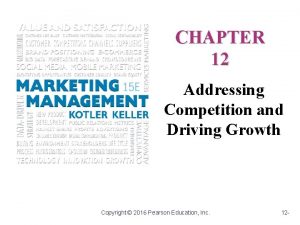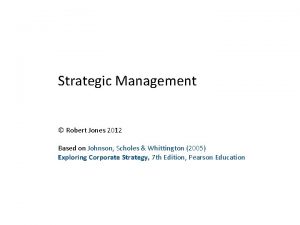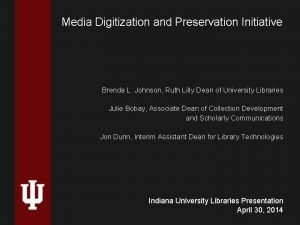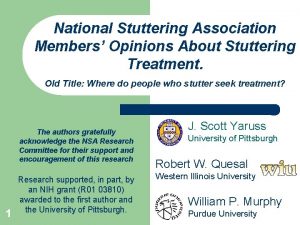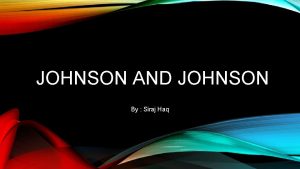3 183 Introduction to Stuttering Anticipation Knott Johnson

















- Slides: 17

3: 183 Introduction to Stuttering

Anticipation • Knott, Johnson, Webster (1937) • Adults who stutter indicated when expect to stutter while reading passage • 96% of anticipations did result in stuttering • 94% of all words stuttered were anticipated

Anticipation • Knott, Johnson, Webster (1937) • Adults who stutter indicated when expect to stutter while reading passage • 96% of anticipations did result in stuttering • 94% of all words stuttered were anticipated

Anticipation • If stuttering is the result of the expectancy to stutter, or what an individual does to not stutter, shouldn’t all stuttering be anticipated? • Some people who stutter cannot predict impending stuttering • Anticipation not as prevalent in children

Anticipation • Johnson interpreted such findings as resulting from a “low degree of consciousness” • Apparently, stuttering can be anticipated without being highly aware of it

VARIABLES THAT INFLUENCE STUTTERING FINDINGS • • Singing Talking to beat of metronome Whispering Oral reading in unison Altered auditory feedback (DAF, FAF) Talking in presence of noise (masking) Talking in a different manner (e. g. acting)

Explanations • Change in vocal function – Altered vocalization or prosody – Reduced inflection – Slowed rate • Other explanations – Novel situation – Distraction – Utilizing different neural circuits, avoiding the deficits that underlie stuttering

Use in Therapy • Allow individual to feel what it’s like to speak fluently – make changes • Increase confidence in individual • Use to create fluency in specific situations • Use to generalize to other situations • Obtain information about way individual stutters

• How might conditions/variables discussed in this section be used in the clinic? • Which ones are most useful in therapy room? When the client is on his own? • How might these conditions/variables generalize to other situations?

Stuttering in the media • How are PWS portrayed in the media? – Comic relief (e. g. porky pig) – Depict weakness and fear (e. g. Primal Fear, A Fish Called Wanda, The Cowboys) – Depict incompetence (My Cousin Vinny) – Depict a twisted-evil soul (Criminal Minds, CSI)

Stuttering in the media • There are some positive examples: – The King’s Speech – Rocket Science

Anxiety • Trait vs. State Anxiety • Trait anxiety is a stable characteristic • State anxiety comes and goes (fleeting) and is often context dependent • Adults who stutter tend to have higher state but not trait anxiety (Alm, 2007) and the state anxiety is related to stuttering • Anxiety is a consequence of stuttering and not causal

Social Anxiety • Social anxiety is a natural consequence of: – Negative listener reactions – Stereotypes – bullying and teasing – Social isolation – Rejection and relationship difficulties – Educational and occupational underachievement – expectancies of social harm – fear of speaking in social situations

Stuttering effects on social and emotional factors • Bullying – Children who stutter are bullied more often than fluent speakers (Blood, et al. 2011) – Bullying negatively affects self-esteem (Blood, 2004) – Bullying decreases psychosocial outcomes (e. g. less optimistic and lower satisfaction with life) – Leads to increased social isolation and anxiety

Stuttering effects on social and emotional factors • Inter-personal relationships – Due to fear of negative consequences in social situations, stuttering may interfere with creating and/or maintaining personal relationships

Stuttering effects on social and emotional factors • Vocational impacts – 85% of employers agreed that stuttering decreases a persons employability (Hurst and Cooper, 1983) – PWS have higher rates of unemployment, are discriminated when interviewed for jobs, and are denied promotions because of stuttering (Opp, et al. 1997)

Stuttering and the law • Rehabilitation Act (1973) • Americans with Disabilities Act (ADA) of 1990 • State and local anti-discrimination laws • But is stuttering a disability or handicap? • Andreson v. Fuddruckers, Inc. , Civil Action No. 03 -3294, 2004 WL 2931346 (D. Minn. , Dec. 14, 2004), specifically held that stuttering could qualify as a disability under the ADA.
 Chapter 12 addressing competition and driving growth
Chapter 12 addressing competition and driving growth Responsive anticipation and creative anticipation
Responsive anticipation and creative anticipation Kimberly hill knott
Kimberly hill knott Knott technique
Knott technique Upper extremity pnf patterns
Upper extremity pnf patterns Johnson background
Johnson background Johnson and johnson bcg matrix
Johnson and johnson bcg matrix Laurie johnson brad johnson
Laurie johnson brad johnson Our credo johnson & johnson
Our credo johnson & johnson Johnson and johnson organizational structure
Johnson and johnson organizational structure Johnson and johnson botnet infections
Johnson and johnson botnet infections Johnson background
Johnson background Jjeds employee directory
Jjeds employee directory Johnson and johnson three c's of classroom management
Johnson and johnson three c's of classroom management Johnson and johnson md&d
Johnson and johnson md&d Bermuda on the world map
Bermuda on the world map Convenio 183
Convenio 183 Mari sebarkan injil
Mari sebarkan injil
